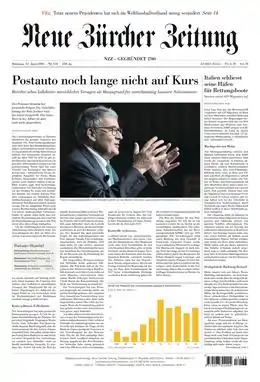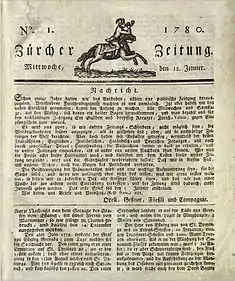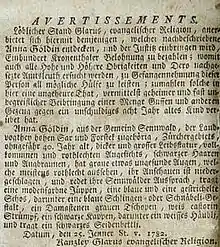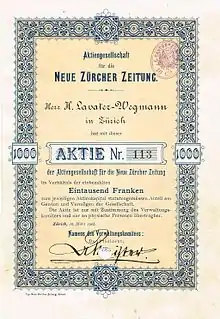Neue Zürcher Zeitung
 | |
| Type | Daily newspaper |
|---|---|
| Format | Swiss |
| Owner(s) | NZZ Mediengruppe |
| Founder(s) | Salomon Gessner |
| President | Felix Graf |
| Editor-in-chief | Eric Gujer |
| Founded | 12 January 1780 |
| Political alignment | Classical liberalism Liberal democracy |
| Language | German |
| Headquarters | Zürich, Switzerland |
| Circulation | 108,709 (including e-paper, 2014) |
| Readership | 0.253 Mio. |
| ISSN | 0376-6829 |
| OCLC number | 698049952 |
| Website | nzz.ch (in German) |

The Neue Zürcher Zeitung (NZZ; "New Journal of Zürich") is a Swiss, German-language daily newspaper, published by NZZ Mediengruppe in Zürich.[1] The paper was founded in 1780. It was described as having a reputation as a high-quality newspaper, as the Swiss-German newspaper of record, and for objective and detailed reports on international affairs.[2]
History and profile



One of the oldest newspapers still published, it originally appeared as Zürcher Zeitung,[3] edited by the Swiss painter and poet Salomon Gessner, on 12 January 1780,[4][5] and was renamed as Neue Zürcher Zeitung in 1821.
According to Peter K. Buse and Jürgen C. Doerr many prestige German language newspapers followed its example because it set "standards through an objective, in-depth treatment of subject matter, eloquent commentary, an extensive section on entertainment, and one on advertising."[6]
Aside from the switch from its blackletter typeface in 1946, the newspaper has changed little since the 1930s. Only since 2005 has it added color pictures, much later than most mainstream papers. The emphasis is on international news, business, finance, and high culture. Features and lifestyle stories are kept to a minimum.
Politically, the newspaper has been positioned close to the liberal Free Democratic Party of Switzerland since its early period.[5] It has a liberal[4] and centre-right orientation.[7]
The appointment of Eric Gujer as editor-in-chief in 2015 and René Scheu as head of the feature section in 2016, as well as almost half of all contributing editors leaving the newspaper between 2015 and December 2017, marked a noticeable shift to the right, according to critics.[8]
Circulation
The circulation of Neue Zürcher Zeitung was 18,100 copies in 1910.[5] It rose to 47,500 copies in 1930 and 66,600 copies in 1950.[5]
In 1997, the Neue Zürcher Zeitung had a circulation of 162,330 copies.[9] Its circulation was 169,000 copies in 2000.[10] The circulation of the paper was 166,000 copies in 2003.[11] The 2006 circulation of the paper was 146,729 copies.[12] Its circulation was 139,732 copies in 2009.[13] In 2010, the paper had a circulation of 136,894 copies.[1]
Weekend edition
In 2002, the newspaper launched a weekend edition, NZZ am Sonntag (NZZ on Sunday).[4] The weekend edition has its own editorial staff and contains more soft news and lifestyle issues than its weekday counterpart, as do most Swiss weekend newspapers. Its circulation was 121,204 copies in 2006.[12]
NZZ am Sonntag was awarded the European Newspaper of the Year in the category of weekly newspaper by the European Newspapers Congress in 2012.[14]
Archives
In 2005, the complete run of the newspaper's first 225 years was scanned from microfilm. A total of two million images comprising seventy terabytes, and its Blackletter type was scanned – using optical character recognition – at a total cost of €600,000 (or €0.30 per image). The result is a searchable digital archive, accessible online by subscribers and publicly on site in Zurich.
The digitization was carried out by an institute of the German research organization Fraunhofer Society – the Institute for Media Communication (since 2006, the Fraunhofer Institute for Intelligent Analysis and Information Systems), headquartered in Sankt Augustin, North Rhine-Westphalia.[15]
NZZ Libro
NZZ Libro is the book publisher of the Neue Zürcher Zeitung (NZZ). Books have been published since 1927; since 1980, the publishing house has been run as a separate profit centre. Since 2006 the publishing house has been operating under the name NZZ Libro. The publishing programme of specialist and non-fiction literature includes, among other things, political, cultural, historical and economic books, as well as biographies and illustrated books, predominantly with a Swiss reference.[16]
Award
The Neue Zürcher Zeitung was the recipient of the 1979 Erasmus Prize.[17]
See also
Notes and references
- Cyril Jost (4 February 2011). "The challenges confronting the Swiss press". InaGlobal. Retrieved 23 December 2014.
- Elizabeth Wiskemann. (1959). A great swiss newspaper: the story of the Neue Zürcher Zeitung Oxford University Press. ASIN B00AVPAYW8
- Hugo Bigi (2012). Journalism Education Between Market Dependence and Social Responsibility: An Examination of Trainee Journalists. Haupt Verlag AG. p. 25. ISBN 978-3-258-07753-6.
- "The press in Switzerland". BBC. 17 May 2004. Retrieved 17 January 2015.
- Ariane Knüsel (1 September 2012). Framing China: Media Images and Political Debates in Britain, the USA and Switzerland, 1900–1950. Ashgate Publishing, Ltd. p. 32. ISBN 978-1-4094-6178-4.
- Peter K. Buse and Jürgen C. Doerr, eds. (1998). Modern Germany: And Encyclopedia of history, people, and culture, 1871–1990 2:786.
- "Neue Zuercher Zeitung". Press Europ.
- Matthias Daum; Caspar Shaller (16 December 2017). ""Neue Zürcher Zeitung": Druck von rechts". Die Zeit (in German). ISSN 0044-2070. Retrieved 10 July 2019.
- Sibylle Hardmeier (1999). "Political Poll Reporting in Swiss Print Media". International Journal of Public Opinion Research. 11 (3). Archived from the original (PDF) on 18 October 2017.
- "Top 100 dailies 2000". campaign. 16 November 2001. Retrieved 2 March 2015.
- "World Press Trends" (PDF). World Association of Newspapers. Paris. 2004. Retrieved 15 February 2015.
- "Swiss newspaper market in flux" (PDF). Swiss Review. 5: 9. October 2007.
- Hugo Bigi (2012). Journalism Education Between Market Dependence and Social Responsibility: An Examination of Trainee Journalists. Haupt Verlag AG. p. 26. ISBN 978-3-258-07753-6.
- "European Newspaper Award 12+1". European Newspaper Congress. Archived from the original on 10 August 2014. Retrieved 1 August 2014.
- Klaus Jacob. (February 2005). "70 Terabyte Zeitgeschichte" Archived 19 July 2011 at the Wayback Machine. Fraunhofer Magazin. Retrieved 23 August 2012.
- "NZZ Libro" (in German). NZZ. Retrieved 23 February 2018.
- "Erasmus Prize". The Age (via Google News). 21 September 1979. Retrieved 23 August 2012. "The 1979 Erasmus Prize for outstanding contribution to European culture was presented jointly yesterday to the Swiss daily newspaper 'Neue Zuercher Zeitung' and the West German weekly 'Die Ziet'."
Further reading
- Luchsinger, Fred. Neue Zürcher Zeitung im Zeitalter des zweiten Weltkrieges, 1930–1955 (Zürich: Neue Zürcher Zeitung, 1955)
- Merrill, John C. and Harold A. Fisher. The world's great dailies: profiles of fifty newspapers (1980) pp. 211–219
- NZZ (Zürich: Neue Zürcher Zeitung, 2013)
- Wiskemann, Elizabeth. A great swiss newspaper: the story of the Neue Zürcher Zeitung (Oxford University Press, 1959)
- Friedemann Bartu: Umbruch. Die Neue Zürcher Zeitung. Ein kritisches Porträt. Orell Füssli, Zurich 2020, ISBN 978-3-280-05716-2.
External links
- (in German) Official website
- Digitised version of Neue Zürcher Zeitung on the Swiss platform of digitised newspapers e-newspaperarchives.ch